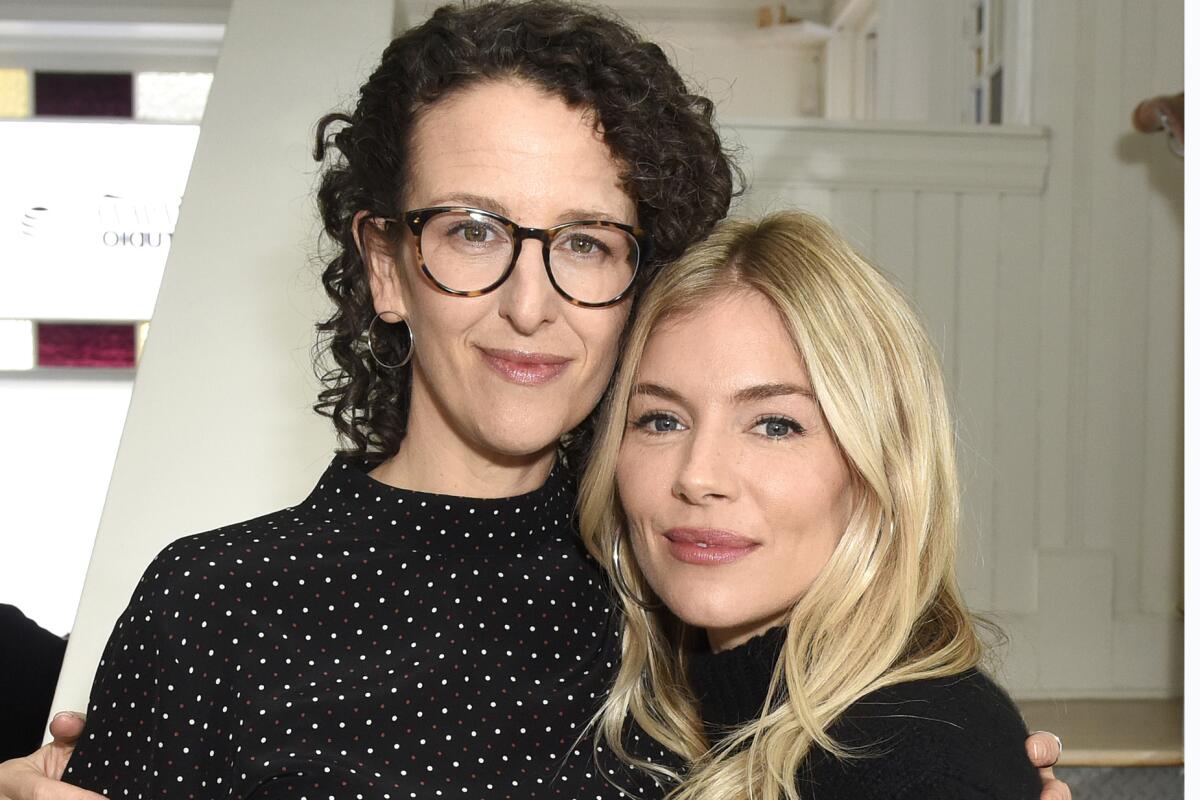Sienna Miller inhabits ‘Wander Darkly’s’ unsettling personal story
The unusual structure of “Wander Darkly” — a woman (played by Sienna Miller) may or may not be dead and is reliving scenes with her significant other (who may or may not be there with her) makes for a surprisingly affecting, if unsettling, experience. Miller and writer-director Tara Miele — whose own experiences with a serious car accident shaped the story’s creation — joined The Envelope via Zoom to discuss the nature of subjective memories, mansplaining and the transcendent nature of dolphins.
You two paired up initially because Diego Luna (as Matteo) and Sienna share an agent, who showed Sienna the script. But what sold you on each other?
Sienna Miller: When I read the script, I fell in love with it. I’ve never advocated for myself in that way before.
Tara Miele (deadpan): I had initially planned on casting, like, the most beautiful woman in the world to play me in a movie about myself. (Laughs) But I was excited that [Sienna] was lobbying, and she was so down for the raw way I wanted to shoot this — she got it in a very personal way. It was just hers; that was the truth of it.
What does it mean to shoot in a “raw” way? And how do you prep for that, Sienna?
Miller: I want to push myself to uncomfortable places. This was such an interior experience of grief that it was fascinating. There’s catharsis for me in pushing myself into horrible places. It’s so painful and terrifying, but you feel great afterward.
Miele: I felt like Sienna and I saw each other in that shared pain of artistry. It’s hard for actresses to be flawed on screen, so it was important for me to have an actress in this role who was willing to be messy and ugly and not wear makeup every day. I kept telling the crew, “Don’t shoot her like she’s a model.” Give her that respect, let her tell a human story.
How did knowing the character was actually based on Tara change the way you portrayed her, Sienna?
Miller: Knowing it was so personal to her galvanized the work, to a degree. [To Miele] When I first met you, I was studying you; there were little mannerisms of yours in there. I think I sound a little bit like you.
Miele: At Sundance, my mother came up to Sienna and was like, “Oh, my God, it was like I was watching Tara.” It got really weird.
That character, Adrienne is an unreliable narrator, but there are some scenes where Matteo is mansplaining her life to her. Do you think we’re seeing this story play out differently in 2020 than if it had come out just five years earlier?
Miele: He does sort of try to mansplain her in a way — and she takes the narrative back. This movie is such a Rorschach test: Some women watch it and say, “He totally abandoned her.” And then some men are like, “I appreciated that he had a point of view.” Even in test screenings, people were fighting about who was right and who was wrong.
Miller: Our own experiences of a given moment can be so at odds with our partners’, stored in the memory bank in a completely different way. Adrienne is so intuitive — she knows something happened. I think that really lands with people, when you recall moments in your lives and think we might be wrong.
Miele: I’m interested in that whatever story we tell about our past is inevitably the story that we will play out in our future. So, moving past the victimization or trauma. I’ve made this movie maybe as a reminder to myself to continue to say “thank you” for all the lucky things we have. That we’re still here, you know?
Some of the most indelible images in the film are the appearances of the dolphins. What inspired that, in particular?

Miele: When my husband and I were dating early on, we were in Bali, and we did this thing where they wake you up in the morning and take you out to see dolphins. At the time, that might have been the most beautiful thing I’ve ever experienced in my life. I wanted to share those feelings. Part of the film is me exorcising my worst demons and nightmares. There was something very Matteo about those dolphins and the chaos of nature, how it can be really beautiful if we allow for it.
Miller: I never say no to a dolphin. But the chaos behind getting that shot was insane. There were two little boats with crew on them and camera equipment and a child — and people were seasick. It looks so perfect, but the behind-the-scenes of that day … the one who was driving the boat vomited all over himself as we were trying to get the shot.
Miele: I’m giving away secrets, but there’s a wide shot toward the end of the movie where he and the translator are there, and he’s getting sick off the boat and looks like a child. It looks so cute, because we didn’t know he was sick at the time we shot it.
And that made it into the film?
Miele: It did. Everyone was like, “You’re out of your mind.” And I was like, “I will show you dolphins. Just wait. We will get these dolphins.”
More to Read
From the Oscars to the Emmys.
Get the Envelope newsletter for exclusive awards season coverage, behind-the-scenes stories from the Envelope podcast and columnist Glenn Whipp’s must-read analysis.
You may occasionally receive promotional content from the Los Angeles Times.










